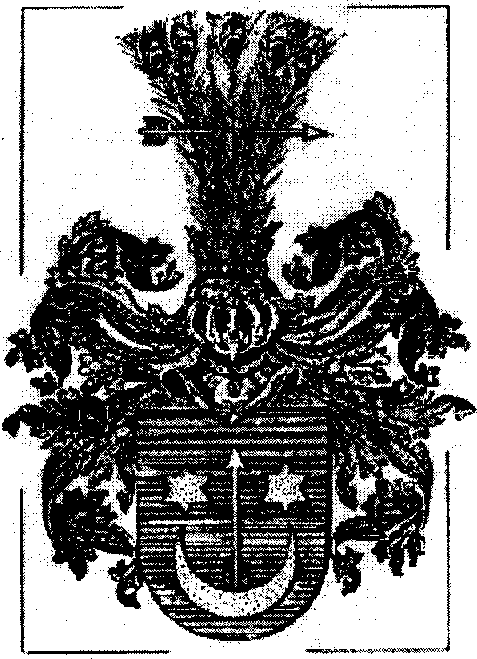Herb Sas
Research Heraldry Herb Sas
Herbarz Polski translation
Sas herb
 For each herb [clan shield, coat of arms] the blazon or verbal description of the arms is first given in authentic heraldic style, followed by a translation from the Polish description by Niesiecki. The right and left sides of a shield are identified from the standpoint of the bearer, i. e., the one holding the shield. His right would be your left and vice versa. The tinctures (colors) in heraldry are as follows: azure = blue, gules = red; sable = black; or = gold, argent = silver; vert = green. In heraldry all charges (pictures) on a shield are assumed to be facing dexter (right side) unless otherwise specified. In Polish heraldry all animals or birds are assumed to be in their natural coloring unless otherwise specified.
For each herb [clan shield, coat of arms] the blazon or verbal description of the arms is first given in authentic heraldic style, followed by a translation from the Polish description by Niesiecki. The right and left sides of a shield are identified from the standpoint of the bearer, i. e., the one holding the shield. His right would be your left and vice versa. The tinctures (colors) in heraldry are as follows: azure = blue, gules = red; sable = black; or = gold, argent = silver; vert = green. In heraldry all charges (pictures) on a shield are assumed to be facing dexter (right side) unless otherwise specified. In Polish heraldry all animals or birds are assumed to be in their natural coloring unless otherwise specified.
Arms: azure, a crescent moon, at each tip a six-pointed star, all or. Between the horns, an arrow in pale point to chief argent. For a crest, out of a ducal coronet, a panache of peacock plumes debruised of an arrow in fess argent.
A new moon of gold on the shield, with its horns pointed straight upwards; on each horn a six-pointed star. In its center an arrow with its head straight up, all in a blue field. On a crowned helmet a spread peacock's tail, pierced by an arrow from the shield's right side to left. Thus Paprocki describes these arms in O Herbach, p. 547, also Okolski, volume 3, p. 195. The latter says that origin of these arms was in Saxony, and thus they are called Sas [Sas is Polish for "Saxon"], and they came from Saxony to Hungary. According to Wojciech Strepa, from there Count Hujd, having come with a small army to Lew, prince of Ruthenia, and having allied himself with Lithuania, devastated Mazovia. In reward for his knightly deeds, he was given, among other gifts, Lew's near relative as a wife; he settled in Ruthenian territory, and by his descendants he became the father of the various families who use these arms in their seals. Paprocki concludes that at one time this was a mighty house in Hungary, because ducats have been seen stamped with their arms, evidently from when their ancestors were controllers of the mint and had such a coin struck.
Some bear this coat of arms with the design completely reversed [i.e., upside down], as I discussed in the entry on the Garczynski's. The Msciszewski's (q. v.) bear arms much like those of Sas, but they omit the arrow, and the stars are arranged in a row. The Dziedziel's also use these arms in another form, see volume 3, p. 465.
Bearers of These Arms
|
Baczynski |
Manesterski |
|
Bandrowski |
Msciszewski |
|
Baraniecki |
Nowosielski |
|
Bereznicki |
Odrzechowski |
|
Bilinski |
Orlowski |
|
Blazowski |
Podwysocki |
|
Bojarski |
Raszkowski |
|
Bratkowski |
Roiniatowski |
|
Brylinski |
Rudnicki |
|
Brzescianski |
Siemiasz |
|
Buchowski |
Skotnicki |
|
Chodkowski |
Strutynski |
|
Czolhanski |
Sulatycki |
|
Danilowicz |
Swistelnicki |
|
Dlugopolski |
Tarnawski |
|
Dobrzanski |
Tatomir |
|
Dubrawski |
Terlecki |
|
Dziedoszycki |
Tesmer |
|
Dziedziel |
Tyssarowski |
|
Hoszowski |
Uniatycki |
|
Hrebnicki |
Winnicki |
|
Hubernicki |
Wislocki |
|
Jaminski |
Witwicki |
|
Jasinski |
Wolkowicki |
|
Jaworski |
Wolosiecki |
|
Klodmcki |
Woryski |
|
Komarnicki |
Zaplatynski |
|
Kropiewnicki |
Zawisza |
|
Kruszelnicki |
Zeliborski |
|
Litynski |
Zestelinski |
|
Lucki |
Zurakowski |
|
Manczak |
Zukotynski |
[Added by the 19th century editor, Bobrowicz:] Dunczewski, Kuropatnicki, Malachowski, and Wieladek's armorials give these families as also using Sas arms:
|
Brzuski |
Olewnicki |
|
Charewicz |
Pochorecki |
|
Husarzewski |
Popiel |
|
Kumarnicki |
Sasimowski |
|
Nechrebecki |
Sasowski |
|
Obertynski |
Tyzdrowski |
Copyright © 1997 Leonard J. Suligowski. Used by permission. This article originally appeared in Rodziny (August 1997), the journal of the Polish Genealogical Society of America.
;
